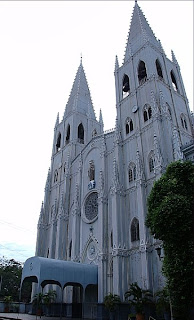Gothic architecture was born in the year 1144AD from the Romanesque but was able to develop and create its own unique style. The transition from Romanesque to Gothic was revolutionary. We must take note that what binds these two styles is their purpose, which was to spread Christianity. These two styles were born during the time when Europe had a very large interest in religion. Gothic architecture was altered slightly as it spread from one country to another. Each one had its idea of what a cathedral must look like, the French focused on height, while the English on its length. But Italy begged to differ and did not accept Gothic architecture. Gothic architecture got its name during the Italian renaissance when people considered structures of the middle ages barbaric thus associated with savage Goths.
Gothic architecture started off with the building of Abby church of St. Denis. The Benedictine abbot Suger wanted a new and impressive structure, so tall it seemed to reach the heavens and a building that everyone would remember. This structure impressed people thus Gothic style quickly spread. And since no city would let others outdo their churches, they aimed to build theirs longer, higher, and more stunning. Since the people during the Gothic period were depressed and experiencing poverty issues, the cathedrals became a place of cooperation and faith. The high ceilings gave them the feeling of enthusiasm and inspiration. The vaulted ceilings more importantly emphasized a connection to heaven and to God.
While Romanesque architecture was designed for protective purposes, Gothic worked for a more artistic approach thus used thinner walls. It was during the Gothic period when there was an avid use of flying buttresses which solved the problem of support during the Romanesque period. Unlike the Romanesque structures wherein windows were very small and few, in Gothic structures windows were very important. They had a lot of huge stained glass windows which depicted biblical figured. These took them months to complete because of their intricate designs. Although hundreds of windows were present, not much light entered the structures cause of the colored glass. The ribbed vault was widely used in this period and was essential to Gothic architecture. It gave builders flexibility of design and construction that wasn’t possible with the groin and barrel vault plus it was stronger and easier to construct. A unique design Gothic cathedrals had were the statues of Gargoyles which they believed helped to ward off evil spirits and served as rain spouts. One good example of a Gothic (revival) structure here in Manila is the Basilica of San Sebastian. The interior of the church displays groined vaults, stained glass windows can be found all over the walls.
 |
| Gargoyles found at the Ulm Munster, Germany. The tallest Gothic church in Germany. |
 |
| The Ulm Munster, Germany |
 |
| Yes, they're the gargoyles from Disney film Hunchback of Notre Dame. :-) Apparently the film features Notre Dame de Paris, a Gothic church in Paris, France. The book The Hunchback of Notre-Dame portrays the Gothic era as one of extremes of architecture and religion. |
 |
| Basilica of San Sebastian, Manila |
I’ve come to realization, that culture and society really did play an important role in the structures of each period. Society itself was translated in the architectural style.
No comments:
Post a Comment